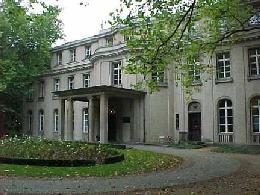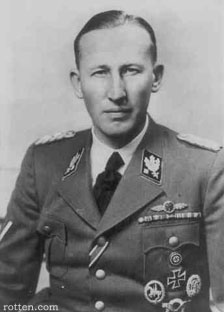 |
 |
THE WANNSEE CONFERENCE
The Wannsee Conference was held on 20 January 1942, in a villa owned by the SS-Nordhav Foundation in the attractive Berlin lakeside suburb of Wannsee. It was presided over by SS-Lieutenant General Reinhard Heydrich, Chief of the Security Police and Security Service. Heydrich summoned fourteen men representing the governmental and military branches most involved in implementing the practical aspects of the Final Solution. Reichsmarschall Hermann Göring had charged him with arranging all practical matters concerning the implementation of the Final Solution of the Jewish question.1 Heydrich was an ambitious and meticulous officer who relished the responsibility of power. One of Heydrich's foremost intentions was to make sure that all these men understood perfectly what duties and responsibilities their office was expected to fulfill.
In the years leading up to World War II, the phrase "Final Solution of the Jewish Problem" had taken on a series of increasingly ominous meanings in the Nazi vocabulary.2 The various implications had included voluntary emigration, confinement to ghettos in cities located along rail lines, forced removal to concentration camps, and finally, extermination. Heydrich wanted to be certain there was no confusion among the group that, now, the term referred specifically to the murder of all European Jews.
Heydrich's assistant, SS Lt-Colonel Adolf Eichmann tells us in testimony at his trial in 1961, that the meeting was relatively brief, lasting only an hour to an hour and a half, and that the atmosphere of the meeting was one of cooperation and agreement.3 These high-ranking members of the Nazi government met at mid-day over a buffet luncheon to discuss the annihilation of an entire people.
Those attending were:
- Gauleiter Dr. Alfred Meyer and Reichamtsleiter (Chief Officer) Dr. Georg Leibrandt - Reich Ministry for the Occupied Eastern Territories
- State Secretary Dr. Wilhelm Stuckart - Reich Ministry of the Interior
- State Secretary Dr. Erich Neumann - Office of the Plenipotentiary of the Four Year Plan
- State Secretary Dr. Roland Freisler - Reich Justice Ministry
- State Secretary Dr. Josef Bühler - Office of Governor General [Poland] representing Hans Frank
- Under State Secretary Martin Luther - Foreign Office
- SS Senior-Colonel Gerhard Klopfer - Party Chancellery representing Martin Bormann
- Ministerial Director Friedrich Kritzinger - Reich Chancellery
- SS Major-General Otto Hofmann - Race and Resettlement Main Office
- SS Major-General Heinrich Müller - Reich Security Main Office
- SS Lt-Colonel Adolf Eichmann - Reich Security Main Office
- SS Senior-Colonel Dr. Eberhard Schöngarth - Commander of the Security Police and the SD in the General Government [Poland]
- SS Major Dr. Rudolf Lange - Commander of Security Police and Security Service for General Commissariat Latvia, as Deputy of Commanding Officer of Security Police and Security Service for Reich Commissariat Ostland [Baltic States and White Russia] Security Police and Security Service. 4
We have access to the minutes of the meeting (Protocol, in German usage) only by chance. In 1947, the Protocol was discovered in the files of one of the attendees, Martin Luther of the Finance Ministry. Years later, Ministerial Director of the Reich Chancellery, Friedrich Kritzinger and Adolf Eichmann described in detail everything that had occurred at the Wannsee conference and acknowledged the criminal nature of the gathering.5
Heydrich began the meeting by establishing the primacy of his authority. This authority transcended geographical boundaries. He briefly described the recent history of Nazi action against the Jews. The goals had been to remove Jews from different sectors of German society and then from German soil. The Reich Central Office for Jewish Emigration had been established to facilitate and encourage Jewish emigration and through its offices, those who could afford it were allowed to leave the country. This process proved to be too slow and too limited in scope. At the time of this meeting, Reichsführer-SS Heinrich Himmler had already stopped emigration.
The Führer had approved a new solution: the evacuation of the Jews to the East. The Protocol states, "These actions are nevertheless to be seen only as temporary relief but they are providing the practical experience that is of great significance for the coming final solution of the Jewish question."
Heydrich continues by enumerating the number of Jews in each country and observes, "Approximately eleven million Jews will be involved�" He further states in the Protocol, "In large, single-sex labor columns, Jews fit to work will work their way eastward constructing roads. Doubtless the large majority will be eliminated by natural causes. Any final remnant that survives will doubtless consist of the most resistant elements. They will have to be dealt with appropriately because otherwise, by natural selection, they would form the germ cell of a new Jewish revival." In other words, none would be allowed to survive.
Beginning with Germany proper and the Protectorate of Bohemia and Moravia, Europe was to be cleared of Jews from west to east. This brought up a number of difficult questions to be resolved. First, who was a Jew? Would any Jews be exempt? Jewish Veterans who served Germany and were decorated in WWI? Jews married to Germans? Those of mixed blood (Mischlinge) married to Germans? Would sterilization be an alternative? Would those Jews be spared whose labor was necessary for the war effort? Nearly one third of the Protocol is devoted to these complicated matters, not all of which were resolved at this meeting.6
Eichmann tells us that the first part of the meeting was more or less a monologue by Heydrich and the last part, a summary of several positions put forward by individuals at the table.
- SS-Gruppenführer Hofmann was in favor of sterilization instead of "evacuation" for half Jews (Mischlinge). Heydrich replied that a decision should be made on a case-by-case basis. He also spoke of an old people's ghetto, possibly Theresienstadt, to ward off anticipated interventions over individual cases.7
- Stuckart of the Ministry of the Interior proposed compulsory divorce for Germans married to Jews.
- Erich Neumann from the Four Year Plan organization said that Jews should not be removed from essential enterprises unless replacement labor could be provided. Heydrich agreed, pointing out that this was already the policy.
- Josef Bühler from the General Gouvernment asked that the Final Solution begin in Poland, since there were no major transport or manpower problems. Bühler said the authorities from the General Gouvernment accepted Heydrich's primacy in all matters pertaining to the Jewish question and would support his work. He had but one request -- "that the Jewish question be solved as quickly as possible." 8
A number of those gathered at the conference table had already been actively engaged in the extermination of Jews and Bolsheviks since the summer of 1941. Lange and Schöngarth commanded Einsatzgruppen activities in the Riga District and in Polish Galicia. Heydrich and Müller directed the killing operations of the Einsatzgruppen and Müller forwarded the Einsatz "Incident Reports" [Ereignismeldungen] to the Foreign Office. Eichmann routinely received "Incident Reports" from the Einsatz Units describing the daily tallies of their victims, and had himself witnessed a mass shooting near Minsk.9
By the time of the Wannsee Conference, the Einsatzgruppen operating behind the army front lines, had murdered more than half a million people.10 Mass shootings were not suitable for European Jewry outside the war zone and were also demoralizing for the Nazi troops. This had prompted a search for a more impersonal way of killing large numbers of people. By January 1942, the death camps in Belzec and Chelmno, with their gassing facilities, were already under construction.
The Wannsee Conference was not called to decide the fate of European Jews but to clarify all points regarding their demise. In Eichmann's testimony after the war, he said that Heydrich also intended to implicate, that is, share the guilt with the ministries represented at the table. (The war in Russia had begun to turn against the Germans and for the first time, there was a question about whether or not Germany would win.)
A few days after the conference, each of the attendees received his own numbered copy of the Protocol prepared by Eichmann from shorthand notes. According to Eichmann, Heydrich proofread and polished the summary before he gave it his approval. We also know that the Protocol does not reflect everything that was discussed at the meeting, as Eichmann's words at his trial make clear:
Q. Who spoke of this topic?A[nswer]. I no longer remember all the particulars today, Mr. President, but I know that the gentlemen sat around together and plotted together, and there they, in very direct words - not the words I had to use in the Protocol, but in very direct words - called things as they were, with no attempt to disguise them. I would be unable to remember these things if I did not know that, at the time, I said to myself: Look at Stuckart, who people always considered to be a very scrupulous and fastidious law and order man, and now his tone and all his formulations were very unlike the letter of the law. That's about the only thing that has really stayed in my memory.
Presiding judge: What did he say about this subject?
A. In particular, Mr. President, I would like ...
Q. Not in particular - in general!
A. Murder and elimination and annihilation were discussed.11
Notes
- Lehrer, Stephen, Wannsee House and the Holocaust, p.143:
Complementing the task already assigned to you in the directive of January 24, 1939, to undertake, by emigration or evacuation, a solution to the Jewish question as advantageous as possible under the conditions at the time, I hereby charge you with making all necessary organizational, functional, and material preparations for a complete solution of the Jewish question in the German sphere of influence in Europe. Insofar as the jurisdiction of other central agencies may be touched thereby, they are to be involved. I charge you furthermore with submitting to me in the near future an overall plan of the organizational, functional, and material measures to be taken in preparing for the implementation of the aspired final solution of the Jewish question.
- The Holocaust History Project, Short Essays: What was the Final Solution?
- Stephen Lehrer, Wannsee House and the Holocaust, page 174
- Mark Roseman, The Wannsee Conference and the Final Solution: A Reconsideration, page 158
- Stephen Lehrer, op cit., page 163
- Mark Roseman, op cit., pages 157-172
- Israel Gutman, Encyclopedia of the Holocaust, p. 1593
- Mark Roseman, op cit, page 172
- Gideon Hausner, Justice in Jerusalem, page 75
- Stephen Lehrer, op cit., page 67
- IfZ G 01 Proze�protokoll, Sitzung 107, S. E1-F1
Bibliography
Gutman, Israel (Editor-In-Chief), Encyclopedia of the Holocaust, McMillan Publishing Company, New York, 1990
Hauser, Gideon, Justice in Jerusalem, Harper & Row, New York, 1966
Lehrer, Steven, Wannsee House and the Holocaust, McFarland & Company, North Carolina, 2000
Longerich, Peter (Editor) Die Ermordung der europ�ischen Juden,Serie Piper 1060
Roseman, Mark, The Wannsee Conference and the Final Solution: A Reconsideration, Metropolitan Books, New York, 2002
For related articles on this website, see:
When did Hitler decide on the Final Solution? by Gord McFee
and
An Introduction to the Einsatzgruppen by Yale F. Edeiken
![]()
Note
There are at least two excellent video films based on the Wannsee Conference:
The 1984 Infafilm, The Wannsee Conference, distributed by Prism Entertainment Corporation, is a German production, spoken in German with English subtitles.
The 2001 HBO production, Conspiracy, is readily available at most local video rental stores.
Last modified: February 4, 2004
Technical/administrative contact: [email protected]

